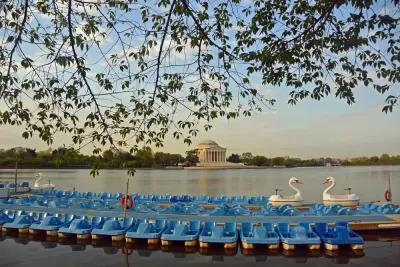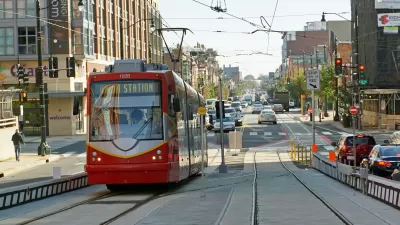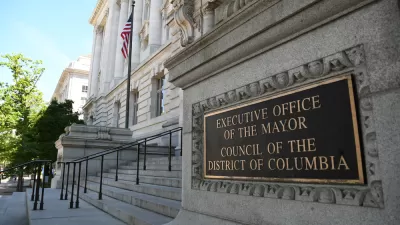The history of Washington, D.C., both recent and distant, has generated one of the most fascinating planning case studies in the country. The man leading the D.C. Office of Planning explains his approach the unique responsibilities of the job.

Washington, D.C., is home to some of the nation's most powerful, privileged, and, depending on voters' tastes, wealthy people. That's literally by design, of course. America's governmental power is ennobled by the city that cradles it. Washington is the only great planned city in the United States and, arguably, it is one of the great planned cities in the world, with both livable, human-scale neighborhoods along with the grandeur and ceremonial beauty fit for kings.
But senators, secretaries, and presidents scarcely concern Eric Shaw. Director of the D.C. Office of Planning since 2015, Shaw is dedicated to an aggressively progressive agenda. Arguably the country's most prominent African-American planner, he speaks of inclusion, equity, and social justice just as readily as he speaks of zoning, technology, and budgets. Shaw has the great fortune to oversee D.C. in a time of plenty. While the city has weathered its share of social and racial strife and political dysfunction, it has in recent years attracted exuberant young residents – and their tax dollars. Its population has grown from by over 100,000 residents since the early 2000s, to 670,000 today. Planetizen's Josh Stephens spoke with Shaw about the opportunities he faces in helping to plan the nation's capital, for the latest installment of the "Planners Across America" series.
What's the biggest item on your agenda at the moment?
The biggest item on our agenda is the amendment of the Comprehensive Plan.
A lot has changed since the original plan was approved in 2006. We're tackling things like developing smart cities and how technology can support our growing neighborhoods. We're thinking about our growth—we've grown faster than we ever thought and in places we never imagined.
The title of our Comprehensive Plan is "Planning an Inclusive City." We're reflecting on a broad range of inclusivity: What is equity? What does inclusivity mean? How does that play out in terms of transit access and affordable housing and jobs and space? Literally, all of my staff, all 70 of them, are working on this probably 90 percent of the time.
You've spoken passionately about equity. What does that mean to you, how do you see it playing out in D.C.? Can D.C. push back the gentrification specter that so many other cities are facing?
 To me, equity is the ability of a resident to extract the full value of living within a city. That's about housing affordability and choice; that's about mobility; that's about jobs; that's about safety; that's about leisure. And, do people feel like they belong in the city? Do they feel like they can fully function and thrive and perform within that city? When I speak to long-term residents about gentrification, they share concerns about housing costs, unemployment, and loss of community. In the planning office, we are drafting and testing strategies to address those gentrification concerns, but that also realize equitable outcomes so that both long-term and new residents thrive.
To me, equity is the ability of a resident to extract the full value of living within a city. That's about housing affordability and choice; that's about mobility; that's about jobs; that's about safety; that's about leisure. And, do people feel like they belong in the city? Do they feel like they can fully function and thrive and perform within that city? When I speak to long-term residents about gentrification, they share concerns about housing costs, unemployment, and loss of community. In the planning office, we are drafting and testing strategies to address those gentrification concerns, but that also realize equitable outcomes so that both long-term and new residents thrive.
I'm fortunate that our mayor, Muriel Bowser, has committed more than a $100 million a year towards the production of affordable housing. We've created a fund to preserve rental housing. We're having real conversations with the community, not just about the redevelopment of public housing, but also the quality of design, the quality of place, the ability to be integrated into surrounding communities.
A lot of that is tied to data. We have pockets of unemployment that are bigger, and we have pockets of community change in terms of housing prices. We are trying to line up the pieces to understand how this phenomenon is manifesting itself in our neighborhoods, each neighborhood, and in the District of Columbia as a whole, and how we as a government both plan and act to improve outcomes for residents, communities and neighborhoods.
What's it like to be in a city that financially flush at the moment and what's your role in keeping it that way?
It's exciting and scary at the same time.
The one thing that is really hard for planners to do—is to plan off-cycle. You have to be thinking about the low times during the high, and the high times during the low. We are asking in my office what could be immediate, or slow moving shocks to the system that could impact growth? We are drafting policies around resilience to ensure that our Comprehensive Plan is both flexible and responsive to minimize the impact of potential shocks.
Maybe having the resources gives you a critical mass to test ideas and policies. We started inclusionary zoning when the bust was happening, so very little housing was being developed. So everyone goes, "Oh, like, how successful is this program?" Now that it's underway and we're growing, we can see that the program is producing the units we thought it was going to produce. When the boom's happening and you're using private-sector partnerships and other tools to implement an inclusive agenda, you can test and course-correct, which I think is exciting.
D.C. being a relatively small city, totally built out, what are you observing and where is the space for more housing in the district? Or what's the form of more housing in the district?
Well, we are the 21st largest city. Our population is bigger than some states. We do, however, have a smaller footprint, but the District is getting control of more federal land to do development of significant size. We have Walter Reed. We have Hill East on Capitol Hill. We have St. Elizabeths. These parcels have the potential to contain multiple neighborhoods. It's my expectation that all of these developments will embody all the values we have in this city—the greenest, most equitable, most walkable, manifesting in all of our planning goals.
In regards to the capital coming in and people who are buying houses, we legitimately are trying to be explicit with developers and builders and even people trying to renovate their homes, that this is what we expect of you. We call it "D.C. Values." We want you to think about inclusiveness. We want you to think about strong design. We want you to be mindful of the historic character and fabric. That's a conversation you have to have every day.
Let's talk about Donald Trump.
Yes.
Given that he is your most prominent sometime-resident, and there are so many discussions about the impact of the Trump Administration on cities, what insight do you have?
Our mayor was the second mayor to talk to him, after [New York Mayor Bill] De Blasio. She has said she is less worried about Trump and more worried about Congress. With us not having representation in Congress, there's always a fear that they are going to meddle.
Mayor Bowser has shared with Mr. Trump how to support the District. She laid out, in her State of the District address, development opportunities that we haven't been able to realize because of impasses with federal agencies. She identified a number of properties she believes would catalyze development and challenged Trump to get the deal done.
In developing the Old Post Office, he and his team interacted with my staff to get required historic preservation approvals. I think that that creates a potential for understanding—he might know the city better than some other cities because he's done business here.
Tell us a little about your background and how you made your way to your current position.
My first job was in Washington, D.C., in the economic development office 15 years ago. I was a junior person, but I was in the room for a lot of the big development moves the city made early on. It is exciting to be leading the planning department now. I have an ability to reflect on what we were thinking when they were done. So that is awesome.
I've worked in Louisiana, Miami, San Jose, and Utah. With all of those, I worked for places that were pursuing innovation, with the resources to execute. In San Jose and Miami, I worked in redeveloping underserved communities. That involved engagement and land trusts and financing and applying smart-growth principles to leverage community benefits agreements. Utah was just awesome, because I was head of everything in the department. I had planning, housing, economic development, arts, engineering, code enforcement and transportation.
It was unexpected when I got the call from then Mayor-elect Bowser's team that I was being considered for the position. And the past 2.5 years have been amazing. Our office and team is recognized by planners and the public as one of the most innovative planning offices in the world.
Let me ask three final real quick questions. In terms of your background, are there any scholars, authors, books, and so forth that you really look to and that you find inspiring?
You know, I don't have a manifesto. I read what's interesting. A lot of stuff on race theory and the history of segregation—that's just an interest of mine. I like to read books on leadership. I'm reading a book by Robert Gates on leadership and public service. I'm 42, and jumped into leadership positions fairly quickly and sometimes you have to read the good stories of other folks to realize where you should go.
What's your advice for people thinking about entering the planning field these days?
I really believe that there is a magic about smaller cities that lets you innovate and grow. One of the things I always tell planners who are coming out of school is to go work for a medium-sized city. They are able to test ideas a little bit differently, the politics are different, and you're empowered in a very different way to make things happen.
What is it like as a planner to work in America's great planned city? What do you owe to Pierre L'Enfant?
It hits me at moments. Some days I am dealing with an addition on top of a row house or street trees. Or I am walking home and I will walk by the White House or I look out the window and I see the Capitol, and I go holy moly, like, wow!
Pierre L'Enfant created the plans that built a city with really good bones, but I feel my charge is about serving the 680,000 residents and millions of worker and visitors. I want to make great neighborhoods, build local narratives and support local prosperity.
I am the first African-American planning director in, I think, 25 years in Washington, D.C. It doesn't make me an expert on black issues, but I know that I want to be intentional in using my authority and my office to try and remedy the outcomes of policies that have impacted my family and my community. I try to make sure I am being honest with myself and honest about my history as I work in one of the most historic cities in the United States.
Conducted in April, this interview has been edited and condensed.

Alabama: Trump Terminates Settlements for Black Communities Harmed By Raw Sewage
Trump deemed the landmark civil rights agreement “illegal DEI and environmental justice policy.”

Planetizen Federal Action Tracker
A weekly monitor of how Trump’s orders and actions are impacting planners and planning in America.

The 120 Year Old Tiny Home Villages That Sheltered San Francisco’s Earthquake Refugees
More than a century ago, San Francisco mobilized to house thousands of residents displaced by the 1906 earthquake. Could their strategy offer a model for the present?

In Both Crashes and Crime, Public Transportation is Far Safer than Driving
Contrary to popular assumptions, public transportation has far lower crash and crime rates than automobile travel. For safer communities, improve and encourage transit travel.

Report: Zoning Reforms Should Complement Nashville’s Ambitious Transit Plan
Without reform, restrictive zoning codes will limit the impact of the city’s planned transit expansion and could exclude some of the residents who depend on transit the most.

Judge Orders Release of Frozen IRA, IIJA Funding
The decision is a victory for environmental groups who charged that freezing funds for critical infrastructure and disaster response programs caused “real and irreparable harm” to communities.
Urban Design for Planners 1: Software Tools
This six-course series explores essential urban design concepts using open source software and equips planners with the tools they need to participate fully in the urban design process.
Planning for Universal Design
Learn the tools for implementing Universal Design in planning regulations.
Clanton & Associates, Inc.
Jessamine County Fiscal Court
Institute for Housing and Urban Development Studies (IHS)
City of Grandview
Harvard GSD Executive Education
Toledo-Lucas County Plan Commissions
Salt Lake City
NYU Wagner Graduate School of Public Service





























